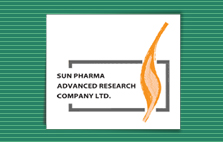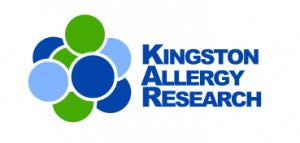Powerpoint presentation








Efficacy of a new nasal steroid, S0597, for the treatment of ragweed
induced allergic rhinitis; tested in an Environmental Exposure Unit (EEU).
Anne K. Ellis, MD MSc FRCPC1,2, Lisa M. Steacy, BSc2, Terry J Walker, BA2, Abhijeet Joshi B Pharm, MBA3,
Shravanti Bhowmik MD3, and Atul Raut, MD, PhD3
1-Department of Medicine, Queen's University, Kingston ON Canada, 2- Allergy Research Unit, Kingston General Hospital, Kingston, ON Canada 3- Sun Pharma Advanced Research Company Ltd., Mumbai, India
Allergic rhinitis (AR) is a significant public health concern worldwide, affecting an estimated 500
Statistical Analyses: Assuming a difference in the change from baseline in TNSS of 1 unit (standard deviation [SD] 1.7)
million people. Intranasal glucocorticosteroids (INS) are regarded as the most effective
between S0597 and placebo, a sample size of 200 evaluable participants was required to assure at least 80% power at a
pharmacologic treatment for AR and are recommended by the Allergic Rhinitis and its Impact on
Asthma guidelines as a first-line therapy. INS have a good safety profile with a low risk of systemic
2-sided α level of 5%, using a t test statistic for equal group sizes. Approximately 288 participants were to be screened to
side effects due to their low systemic bioavailability. This is especially true for newer INS like
randomize 220 participants to the study.
ciclesonide, mometasone furoate, and fluticasone furoate, which all have systemic bioavailability of
The safety population consisted of all randomized participants receiving at least 1 dose of the study treatment. The
primary and secondary efficacy analyses were conducted for the intent-to-treat population. Least-squares mean changes
S0597 is a novel glucocorticosteroid that has been formulated as an intranasal spray for the
in TNSS, TNSS subscales, TOSS, TRSS, PNIF, and PEFR scores from baseline to day 14 were compared among groups using
treatment of seasonal allergic rhinitis (SAR). The short form of its International Union of Pure and
repeated-measures analysis of covariance, with treatment, visit, and treatment-by-visit interaction as fixed effects and
Applied Chemistry name is SFDAC. Results of a phase 1, multiple ascending dose study indicated
that intranasal S0597 was safe and well tolerated at doses up to 3200 µg once daily. No clinically
baseline value as the covariate (treatment comparison at the 2-sided 0.05 significance level). Pairwise treatment
significant suppression of the hypothalamic–pituitary–adrenal (HPA) axis was observed and the
comparisons of each dose of S0597 vs placebo were conducted using the t test. All statistical analyses were performed
plasma concentration of S0597 was below the lower limit of quantification at most time points for
using SAS 9.3 or subsequent versions (SAS Institute, Cary, North Carolina).
all participants.
The aim of the present study was to assess the clinical efficacy, safety, and tolerability of 3
once-daily doses (50, 200, and 400 µg) of S0597 intranasal spray compared with placebo in
participants with SAR who were exposed to ragweed pollen challenges in an environmental
exposure unit (EEU).
Study Design: This was a phase 2, randomized, double-blind, placebo-controlled, single-center, 4-arm,
parallel study conducted in the EEU at Kingston General Hospital, Kingston, Ontario, Canada, between
October 2 and December 17, 2014. Adults with documented SAR during ragweed pollen season were
exposed to controlled levels of ragweed pollen in the EEU. The study was given ethical clearance by the Queen's University Health Sciences and Affiliated Teaching
Hospitals Research Ethics Board. The ClinicalTrials.gov identifier is NCT01940146.
Inclusion criteria: Adult participants (18–65 y) were required to have a minimum 2-year history of SAR
due to ragweed pollen, a positive skin prick test to short ragweed (defined as a wheal ≥3 mm larger than the
negative control) within 12 months prior to enrollment, a total nasal symptom score (TNSS) of at least 6 at
least once during a 1- to 3-hour screening/priming challenge in the EEU and within the first 2 hours of the
Figure 3. TNSS over time (intent-to-treat population).
baseline visit, and forced expiratory volume in 1 minute (FEV1) of at least 80% of predicted during
Table 1: Demographics of the participants at screening (safety
Abbreviations: EEU, environmental exposure unit; SE, standard error; TNSS,
screening. Exclusion criteria: symptomatic perennial AR; clinically significant nasal septum deformation or
total nasal symptom score.
nasal polyps; respiratory tract infection within 2 weeks prior to screening challenge; pulmonary disease
Mean baseline TNSS was between 8.87 and 9.43 across the treatment groups.
other than mild asthma (defined as controlled by β-2 agonists alone used less than 2 times per week);
Data are missing for 1 participant in the S0597 50 µg/day group, 1
Analysis of the primary efficacy end point of change in TNSS from baseline to
history of cataracts, glaucoma, or ocular hypertension; receiving escalating doses of allergen
participant in the placebo group and 1 in the S0597 50 µg/day group.
day 14 demonstrated statistically significantly greater improvement in TNSS
immunotherapy within 2 years prior to screening; receiving other medications that might interfere with
Abbreviation: SD, standard deviation.
in al 3 S0597 dose groups compared with placebo. TNSS declined,
study measurements or rescue medication; pregnancy; breastfeeding; and participation in another clinical
demonstrating symptom improvement in all treatment groups during the 2-
trial within 30 days.
A total of 222 participants were randomized into the study and received
week treatment. The least-squares mean differences in change from baseline
study medication. Thus, al were included in the population for safety
between active treatment and placebo were 1.18, 1.84, and 1.17 for the S0597
Allergen Challenge and Study Treatments
analysis and the intent-to-treat population for the efficacy analysis. The
50, 200, and 400 μg/day groups, respectively; al were statistical y significant.
The ragweed level was maintained at 3500 ± 500 grains/m3 throughout all exposure sessions in the EEU.
mean (SD) age was 39 (10.4) years, 61.3% were female, and most were
None of the exploratory pairwise comparisons between S0597 dose groups
The pollen concentration was monitored via Rotorod® impact samplers placed in 7 different locations in
Caucasian (96.8%), fol owed by Asian (1.4%) .
reached significance. The greater improvement from baseline in TNSS at day
7 was statistical y significant for the S0597 200 μg/day group; least-squares
the room. Samples were taken for 30 seconds at 30-minute intervals, which corresponded with the time
mean difference from placebo 1.25 (95% CI, 0.32–2.18; P = .0088). Similar
points for participant symptom scoring. Participants remained under constant supervision by medical staff
results were seen for the per-protocol analysis set.
inside the unit. A schematic of the EEU is shown in Figure 1.
Participants attended a 3-hour baseline pollen challenge on day 1. Allergen challenge was performed again
on days 7 and 14. At the day 1 visit, the site dispensed study medication for the 13 days of treatment along
with rescue medication and participants were instructed to record study medication administration time,
any missed doses, and any use of rescue medication in a take-home diary. Participants were randomized to
This randomized, double-blind, parallel-group, single-center study assessed the dose-related efficacy and safety of 3 doses of
either S0597 at doses of 50, 200, or 400 µg/day, or placebo as a nasal spray to be administered once daily in
S0597, a novel INS, in participants with SAR who were challenged with ragweed pollen in an EEU.
the evening on days 1 to 13. Study medication was taken onsite following the completion of the EEU
exposure on day 1 (baseline visit) and day 7. On days 2 to 6 and 8 to 13, participants self-administered the
All participants reported nasal symptoms of SAR after pollen challenge and all 3 doses of S0597 (50, 200, 400 µg/day)
medication once daily at home at approximately 9 PM.
showed a statistically significant reduction in nasal symptoms (TNSS) from baseline compared with placebo on day 14. The
Assessments: Nasal symptoms were monitored at the priming visit, and on baseline day 1, day 7, and day
mean improvement in each of the constituent items of the TNSS (rhinorrhea, nasal congestion, sneezing, nasal itching) from
14, immediately prior to pollen exposure in the EEU and at 6 time points (30, 60, 90, 120, 150, and 180
baseline to day 14 was also greater in each of the S0597 groups as compared with placebo. There was no evidence that the
minutes) during the challenge. Nasal assessments included TNSS, total ocular symptom score (TOSS), total
efficacy response consistently increased with increased dose. The S0597 200 μg/day group demonstrated the most
rhinoconjunctivitis symptom score (TRSS), and peak nasal inspiratory flow (PNIF) (See Figure 2). The
consistent response, with statistically significant improvements in all of the nasal symptoms compared with placebo on days
severity of each component symptom was scored from 0 to 3 and the total scores were calculated by adding
the scores for each symptom (Table 1). The average score over the 6 time points during challenge was the
7 and 14. The difference from placebo for change in the rhinorrhea score was statistically significant with all 3 doses of
test result for each visit.
S0597 on day 14. In addition to these symptom scores, there was a statistically significant improvement in measurements of
The primary efficacy end point was TNSS change from baseline to day 14. Secondary efficacy end points
PNIF (data not shown).
were TNSS change from baseline to day 7 and to day 14 in each of the TNSS subscales. Prespecified
As with other new INS therapies, S0597 was well tolerated at the doses tested. The most common AE in each of the
exploratory efficacy end points were TOSS, TRSS, PNIF, and peak expiratory flow rate (PEFR).
treatment groups, including placebo, was a decrease in blood cortisol levels; the incidence appeared to be somewhat higher
among S0597-treated participants compared with those who received placebo, but the event rates were low (2 participants
Figure 1: Schematic of
in the placebo group compared with 3 or 4 in each of the S0597 groups). No dose–response relationship was observed
The pollen is dispensed
among the treatment groups for the incidence of AEs considered severe or for those considered possibly related to study
through the feeder on
the right and the fans
cause a directional flow
to al ow for the pollen to
pass over the seating
area and exhaust
through the back vents.
In conclusion, this study demonstrated that all 3 tested doses of S0597 were effective in relief of nasal symptoms of
Figure 2: Symptom
SAR compared with placebo, and S0597 is a novel intranasal corticosteroid that warrants further development.
Diary Card
The protocol specific
diary card is completed
by each participant as
per the description above
every half hour to
This study was funded by SunPharma Advanced Research Corporation (Mumbai, India). The authors acknowledge Mr. Daniel Adams and Mr. Barnaby Hobsbawn for
determine symptom
their contributions to the successful completion of this study.
Source: http://kingstonallergyresearch.ca/wp-content/uploads/2016/06/EAACI-poster-SunPharma_FNL.pdf
AS/Soc (2010) 12 23 March 2010 Social, Health and Family Affairs Committee The handling of the H1N1 pandemic: more transparency needed Memorandum Rapporteur: Mr Paul FLYNN, United Kingdom, Socialist I. The Parliamentary Assembly has always attentively observed governance issues of the public health
REPUBLIC OF THE GAMBIA MINISTRY OF FINANCE AND ECONOMIC AFFAIRS (MOFEA) BUDGET OF THE GOVERNMENT OF THE GAMBIA 2014 CITIZENS EDITION Republic of The Gambia Citizens Budget Manual Table of Contents List of Abbreviations or Acronyms Statement by the Honorable Minister Section I: Introduction What Government wants to achieve from publishing the 2014 Citizens Budget







